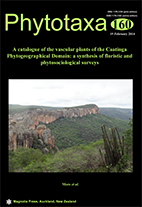Abstract
A catalogue is presented of plant names in use in the Caatinga Phytogeographical Domain (CPD), the largest semiarid ecoregion of South America. We compiled all pubished papers we could locate with floristic and/or phytosociological data relating to the CPD and created a database of all site-based surveys, all names reported in these surveys and the basic ecological data associated with each species. We then mapped the names used in survey reports to those currently accepted in Brazil, consulting specialists to resolve taxonomic and nomenclatural issues before synthesizing the data in order to present here a list of all names in use. Thus this compilation represents the taxonomic data in use by generalist botanists on a sub continental scale. Synthesizing the previously dispersed ecological data available for the species, we explored general ecological patterns in the CPD. We also classified each survey as documenting the flora of a specific type of environment within the CPD and compared the general floristic resemblance between different environments within CPD on a biogeographical scale. Rarefaction curves and species richness estimator indices were employed in order to address the question as to whether or not the Caatinga Phytogeographical Domain can be described as well-sampled. To date over 1700 species have been reported in site-based floristic and phytosociological studies in the CPD. Most surveys focused only on woody plants, ignoring the non woody component, but we show here that a large proportion of the plant biodiversity in the Caatinga is comprised of non woody plants. We estimate that 40% of the existing species were not sampled by site-based surveys. Moreover, most of the species in our database were recorded from a single site, while a few species were considered widespread. When comparing the number of widespread species in our dataset to results published for the cerrado savannas, we show that species in Caatinga seems to have a much more restricted distribution than plants in the Cerrado. We present here a catalogue of all plant names recorded and discuss sampling and geographical issues related to the floristic study of Caatinga.

